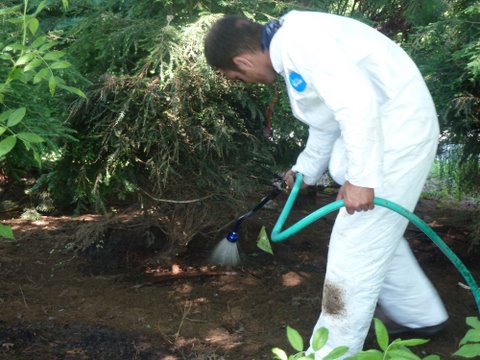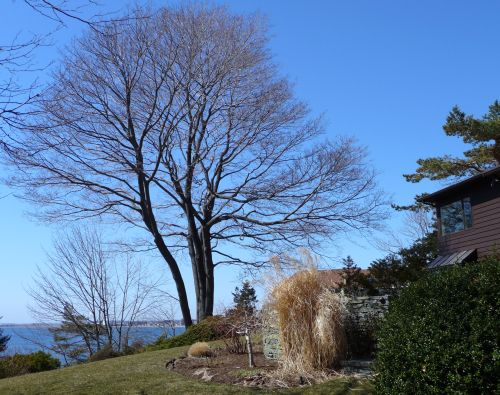It has been a while since I’ve written about root flares. I got some photos from my friend Carl Cathcart the other day, showcasing the excavation of a hemlock root flare. This tree is one of a hedge of 7-8′ tall hemlocks planted two years ago. Its owner had noticed that while the hedge wasn’t failing, it wasn’t exactly thriving, either. He called Carl, a Consulting Arborist, in to inspect the situation.
Carl zeroed in immediately on the base of the tree, and with a little hand excavation discovered that the hemlocks were sitting at least four inches too deep in their root balls. It has been customary for years to plant balled and burlapped trees so that the top of their root balls sits at or slightly above the finish grade around them. Cultivation practices in the growers’ nurseries have changed since that technique became the standard, though, and now it is necessary to check each root ball to make sure that root ball soil is not covering a tree’s root flare. A buried root flare — whether it is buried with root ball soil, compost, or an excess of mulch post-planting — spells trouble for a woody plant, and can be the cause of a tree’s failure to thrive. Small leaves, shorter-than-normal annual twig extension, and thin foliage can all be symptoms of a buried root flare. Root flares are not roots and are not adapted to life under the soil surface; they are part of the tree’s aboveground trunk, and typically need to be exposed to the air.
The in-field solution to this problem (should the excess soil not be removed in the nursery) is to excavate the root flare onsite during project planting. This task should be done before the tree is planted, so that the flare is planted at the correct grade; unfortunately, many contractors are not even aware of the issue, and will not have included time for root excavation in their bid. Here’s where landscape architects can make a major difference in the longevity of their project’s woody plants, and where contractors can distinguish themselves from the competition; LAs aware of the need to excavate root flares should include that requirement in their bid sheets for contractors, and contractors aware of that need (whether they are in a bid situation or not) can use this task, and the benefits it brings to the planted landscape, as a compelling selling point.
When root flare excavation doesn’t take place when the plants go in the ground, the signs of tree stress will likely show up within a year or two. At that point, hand excavation is still possible, but air-tool excavation usually will be more efficient.
When Carl identified the problem, he advised the homeowner to have air-tool excavation done. Matt Foti of Matthew R. Foti Tree and Landscape sent over a crew to carry out the work; Carl’s photos illustrate this post-planting process nicely.
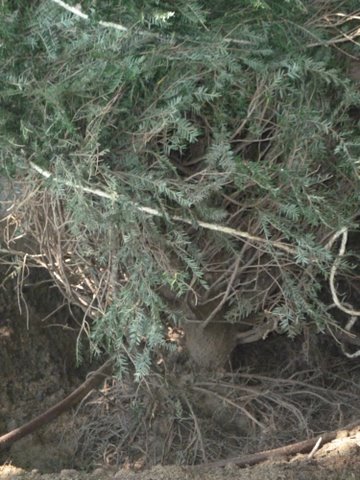
The arborist has tied up the hemlock's branches for easier access in to the root ball. In this photo some of the soil has been blown away already.
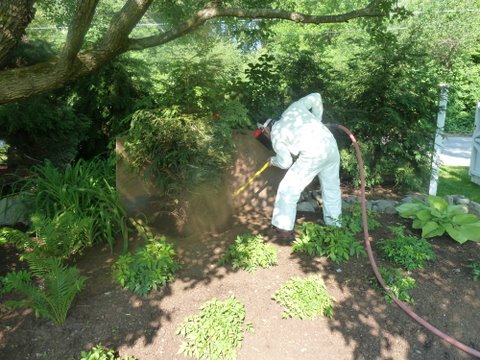
A compressed air tool blows off the root mass. Just visible behind the tree is a plywood barrier that helps keep airborne soil from covering the surrounding plants.

The root flare has been uncovered; note the soil line about four inches up from the root mass. When you see side branches at, just above, or even emerging from below the soil level you can suspect a buried root flare. Carefully scraping away soil at the tree's trunk will indicate if further excavation is necessary. Now that the root flare is exposed, it is possible to see the girdling root that has formed on the trunk's left side.

The girdling root has been cut off, preventing any further vascular constriction in the root coming off the trunk and heading toward the photo's lower left corner.

With the root flare exposed and girdling roots removed, planting soil is blown or shoveled back into the excavated area at the correct grade.
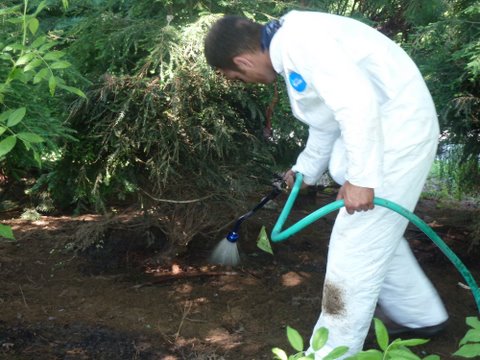
The last step, before untying the branches, is to water the excavated area thoroughly, to rehydrate roots and to eliminate any air pockets in the root mass.
Project site: Private Residence, Sudbury, MA
Consulting Arborist: Carl Cathcart, A Plant Healthcare Consultant
Arborist for root flare excavation: Matthew R. Foti Landscape and Tree Service, Inc.
Read Full Post »
